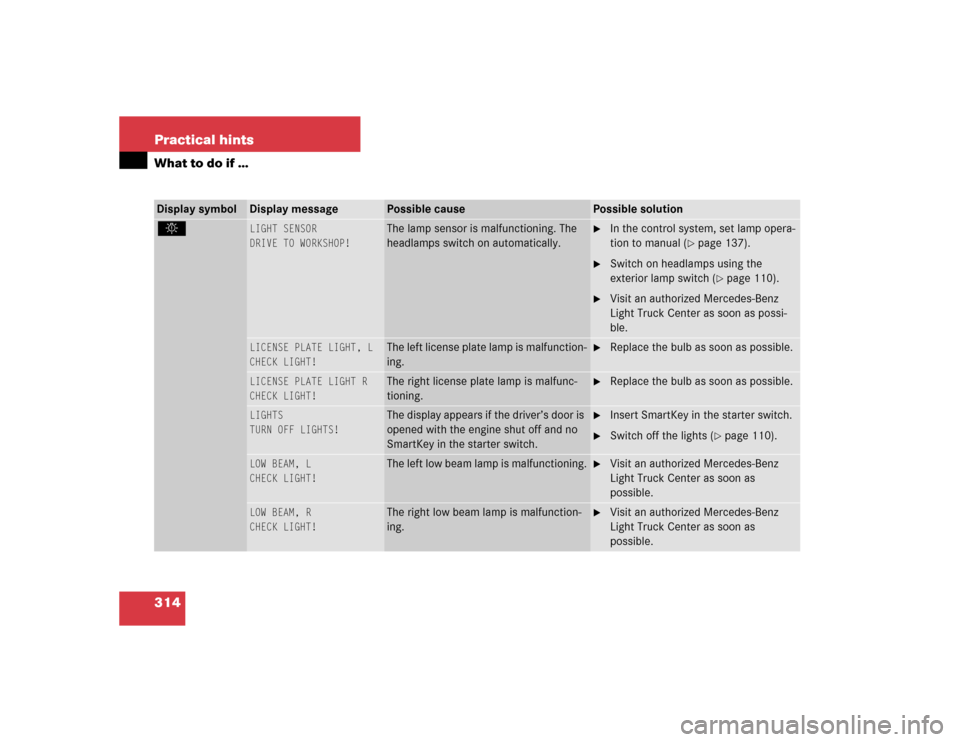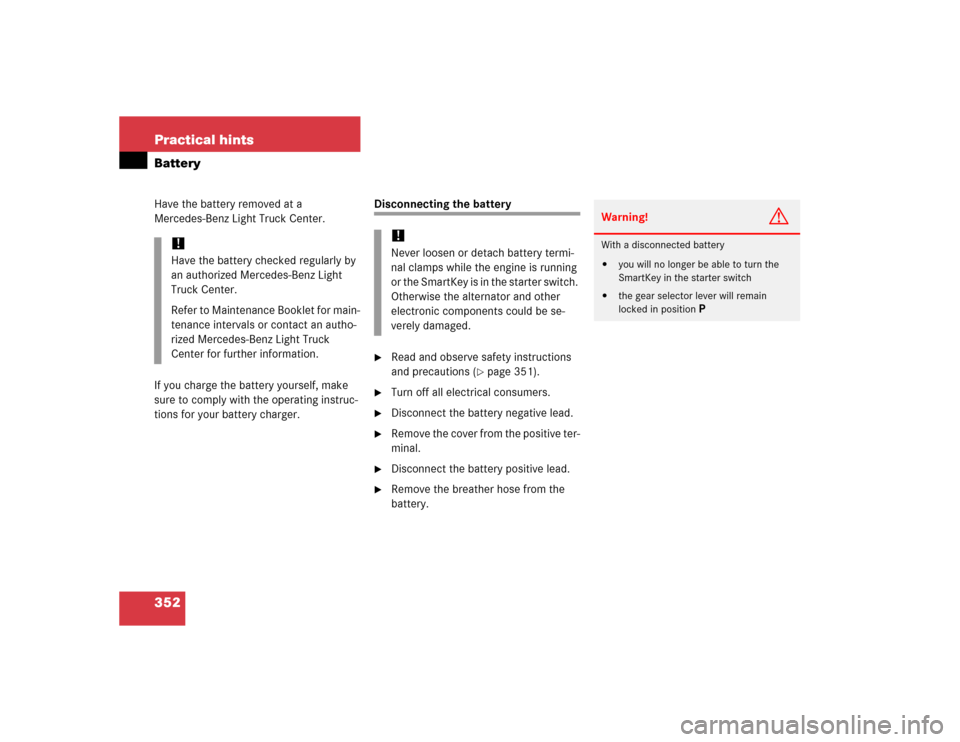Page 305 of 416
305 Practical hints
What to do if …
Display symbol
Display message
Possible cause
Possible solution
B
COOLANT
CHECK LEVEL!
The coolant level is too low.
�
Add coolant (
�page 244).
�
If you have to add coolant frequently,
have the cooling system checked by
an authorized Mercedes-Benz Light
Truck Center.
Warning!
G
Do not spill antifreeze on hot engine parts.
Antifreeze contains ethylene glycol which
may burn if it comes into contact with hot
engine parts. You could be seriously burned.
!Do not ignore the low engine coolant
level warning. Extended driving with
the message and symbol displayed
may cause serious engine damage not
covered by the Mercedes-Benz Limited
Warranty.
Do not drive without sufficient amount
of coolant in the cooling system. The
engine will overheat causing serious
engine damage.
Observe the coolant temperature dis-
play (
�page 120).
Page 307 of 416
307 Practical hints
What to do if …
Display symbol
Display message
Possible cause
Possible solution
Ï
COOLANT
STOP, ENGINE OFF!
The poly-V-belt could be broken.
�
Stop immediately and check the
poly-V-belt.
If it is broken:
�
Do not continue to drive. Otherwise
the engine will overheat due to an
inoperative water pump which may re-
sult in damage to the engine. Notify an
authorized Mercedes-Benz Light Truck
Center.
If it is in order:
�
Do not continue to drive the vehicle
with this message displayed. Doing so
could result in serious engine damage
that is not covered by the
Mercedes-Benz Limited Warranty.
�
Observe the coolant temperature
display (
�page 120).
�
Drive immediately to the nearest au-
thorized Mercedes-Benz Light Truck
Center.
Page 310 of 416

310 Practical hintsWhat to do if …Display symbol
Display message
Possible cause
Possible solution
:
ENGINE OIL LEVEL
REDUCE OIL LEVEL!
You have added too much engine oil.
There is a risk of damaging the engine or
the catalytic converter.
�
Have oil siphoned or drained off. Ob-
serve all legal requirements with re-
spect to its disposal.
ENGINE OIL LEVEL
STOP, ENGINE OFF!
There is no oil in the engine. There is a
danger of engine damage.
�
Carefully bring the vehicle to a halt as
soon as possible.
�
Turn off the engine.
�
Add engine oil (
�page 243) and check
the engine oil level (
�page 240).
ENGINE OIL
VISIT WORKSHOP!
It may be that there is water in the engine
oil.
�
Have the oil checked.
ENGINE OIL LEVEL
VISIT WORKSHOP!
The engine oil has dropped to a critical
level.
�
Check the engine oil level
(�page 240) and add oil as required
(�page 243).
�
If you must add engine oil frequently,
have the engine checked for possible
leaks.
The measuring system is malfunctioning.
�
Have the measuring system checked
by an authorized Mercedes-Benz Light
Truck Center.
Page 314 of 416

314 Practical hintsWhat to do if …Display symbol
Display message
Possible cause
Possible solution
.
LIGHT SENSOR
DRIVE TO WORKSHOP!
The lamp sensor is malfunctioning. The
headlamps switch on automatically.
�
In the control system, set lamp opera-
tion to manual (
�page 137).
�
Switch on headlamps using the
exterior lamp switch (
�page 110).
�
Visit an authorized Mercedes-Benz
Light Truck Center as soon as possi-
ble.
LICENSE PLATE LIGHT, L
CHECK LIGHT!
The left license plate lamp is malfunction-
ing.
�
Replace the bulb as soon as possible.
LICENSE PLATE LIGHT R
CHECK LIGHT!
The right license plate lamp is malfunc-
tioning.
�
Replace the bulb as soon as possible.
LIGHTS
TURN OFF LIGHTS!
The display appears if the driver’s door is
opened with the engine shut off and no
SmartKey in the starter switch.
�
Insert SmartKey in the starter switch.
�
Switch off the lights (
�page 110).
LOW BEAM, L
CHECK LIGHT!
The left low beam lamp is malfunctioning.
�
Visit an authorized Mercedes-Benz
Light Truck Center as soon as
possible.
LOW BEAM, R
CHECK LIGHT!
The right low beam lamp is malfunction-
ing.
�
Visit an authorized Mercedes-Benz
Light Truck Center as soon as
possible.
Page 352 of 416

352 Practical hintsBatteryHave the battery removed at a
Mercedes-Benz Light Truck Center.
If you charge the battery yourself, make
sure to comply with the operating instruc-
tions for your battery charger.
Disconnecting the battery�
Read and observe safety instructions
and precautions (
�page 351).
�
Turn off all electrical consumers.
�
Disconnect the battery negative lead.
�
Remove the cover from the positive ter-
minal.
�
Disconnect the battery positive lead.
�
Remove the breather hose from the
battery.
!Have the battery checked regularly by
an authorized Mercedes-Benz Light
Truck Center.
Refer to Maintenance Booklet for main-
tenance intervals or contact an autho-
rized Mercedes-Benz Light Truck
Center for further information.
!Never loosen or detach battery termi-
nal clamps while the engine is running
or the SmartKey is in the starter switch.
Otherwise the alternator and other
electronic components could be se-
verely damaged.
Warning!
G
With a disconnected battery�
you will no longer be able to turn the
SmartKey in the starter switch
�
the gear selector lever will remain
locked in position
P
Page 354 of 416

354 Practical hintsJump starting
If the battery is discharged, the engine can
be started with jumper cables and the bat-
tery of another vehicle. Observe the
following:�
Jump starting should only be performed
when the engine and catalytic convert-
er are cold.
�
Do not start the engine if the battery is
frozen. Let the battery thaw out first.
�
Only use 12 volt battery to jump start
your vehicle. Jump starting with a more
powerful battery could damage the ve-
hicle’s electrical system, which will not
be covered by the Mercedes-Benz
Limited Warranty.
�
Use only jumper cables with sufficient
cross-section and insulated terminal
clamps.
�
Always make sure the jumper cables
are not on or near pulleys, fans, or
other parts that move when an engine
is started or running.
Warning!
G
Failure to follow these directions will cause
damage to the electronic components, and
can lead to a battery explosion and severe
injury or death.
Never lean over batteries while connecting
or jump starting, you might get injured.
Battery fluid contains sulfuric acid. Do not
allow this fluid to come in contact with eyes,
skin or clothing. In case it does, immediately
flush affected area with water, and seek
medical help if necessary.
A battery will also produce hydrogen gas,
which is flammable and very explosive. Keep
flames or sparks away from battery, avoid
improper connection of jumper cables,
smoking, etc.
Attempting to jump start a frozen battery
can result in it exploding, causing personal
injury.
Read all instructions before proceeding.
!Avoid repeated and lengthy starting at-
tempts.
Do not attempt to start the engine us-
ing a battery quick charge unit.
If engine does not run after several un-
successful starting attempts, have it
checked at the nearest authorized
Mercedes-Benz Light Truck Center.
Excessive unburned fuel generated by
repeated failed starting attempts may
damage the catalytic converter and
may present a fire risk.
Make sure the jumper cables do not
have loose or missing insulation.
Make sure the cable clamps do not
touch any other metal part while the
other end is still attached to a battery.!Do not tow-start the vehicle.
Page 355 of 416

355 Practical hints
Jump starting
The jump-start contacts are located in the
engine compartment.�
Make sure the two vehicles do not
touch.
�
Turn off all electrical consumers.
�
Apply parking brake.
�
Shift gear selector lever to positionP.1Cover
2Positive (+) terminal
3Negative (-) terminal
�
Open cover1 of the positive terminal
of both vehicles.
�
Connect the positive terminals2 of
the batteries with the jumper cable.
Clamp cable to charged battery first.
�
Start engine of the vehicle with the
charged battery and run at idle speed.
�
Connect negative terminals3 of the
batteries with the jumper cable. Clamp
cable to charged battery first.
�
Start the engine of the disabled
vehicle.
Now you can again turn on the electrical
consumers. Do not turn on the lights under
any circumstances.
�
Remove the jumper cables first from
negative terminals3 of the batteries
and then from positive terminals2.
You can now turn on the lights.
�
Have the battery checked at the
nearest authorized Mercedes-Benz
Light Truck Center.
Warning!
G
Keep flames or sparks away from battery.
Do not smoke.
Observe all safety instructions and precau-
tions when handling automotive batteries
(�page 351).
Page 378 of 416

378 Technical dataFuels, coolants, lubricants, etc.Coolants
The engine coolant is a mixture of water
and anticorrosion / antifreeze, which pro-
vides:�
Corrosion protection
�
Freeze protection
�
Boiling protection (by increasing the
boiling point)
The cooling system was filled at the factory
with a coolant providing freeze protection
to approximately -35°F (-37°C) and corro-
sion protection.
If the antifreeze mixture is effective to
-22°F (-30°C), the boiling point of the cool-
ant in the pressurized cooling system is
reached at approximately 266°F (130°C).
The coolant solution must be used year
round to provide the necessary corrosion
protection and increase boil-over protec-
tion. Refer to Maintenance Booklet for
replacement interval.Coolant system design and coolant used
determine the replacement interval. The
replacement interval published in the
Maintenance Booklet is only applicable if
MB 325.0 anticorrosion/antifreeze solu-
tion or other Mercedes-Benz approved
products of equal specification (see
Factory Approved Service Products
pamphlet) are used to renew the coolant
concentration or bring it back up to the
proper level.
To provide important corrosion protection,
the solution must be at least 45% anticor-
rosion/antifreeze (equivalent to freeze
protection to approx. - 22°F [-30°C]).
If you use a solution that is more than 55%
anticorrosion/antifreeze (freeze protec-
tion to approx. - 49°F [-45°C]), the engine
temperature will increase due to the lower
heat transfer capability of the solution.
Therefore, do not use more than this
amount of anticorrosion/antifreeze.If the coolant level is low, water and MB
anticorrosion /antifreeze should be used
to bring it up to the proper level (have cool-
ing system checked for signs of leakage).
Please make sure the mixture is in accor-
dance with label instructions.
The water in the cooling system must meet
minimum requirements, which are usually
satisfied by normal drinking water. If you
are not sure about the water quality, con-
sult an authorized Mercedes-Benz Light
Truck Center.